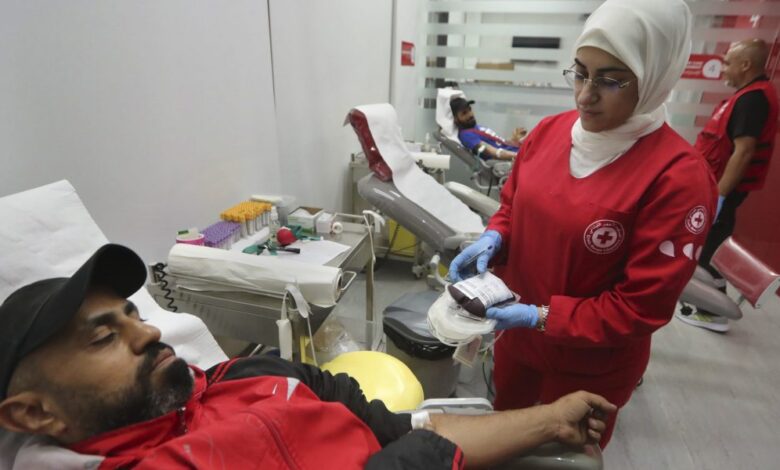Experts explain why hundreds of Hezbollah pagers exploded at once


In what seems like a sophisticated, remote attackPagers used by hundreds of Hezbollah members exploded almost simultaneously in Lebanon and Syria on Tuesday, killed at least nine people — including an 8-year-old girl — and injured thousands of others.
The Iran-backed militant group blamed Israel for the deadly blast, which targeted a large number of people and showed signs of being a long-planned operation. The exact method of the attack remains largely uncertain, and investigators did not immediately say how the pager was detonated. The Israeli military declined to comment.
Here’s what we know so far.
Why were pagers used in the attack?
Hezbollah leader Hassan Nasrallah had previously warned members of the group not to carry mobile phones, saying they could be used by Israel to monitor the group’s activities. As a result, the group uses pagers to communicate.
A Hezbollah official told The Associated Press that the explosive devices were from a new brand that the group had not used before. The official, who spoke on condition of anonymity because he was not authorized to speak to the press, did not name the brand or supplier.
Nicholas Reese, a visiting lecturer at the Center for Global Affairs at New York University’s School of Professional Studies, explains that smartphones are more vulnerable to eavesdropping than simpler pager technology.
Reese, who previously worked as an intelligence officer, said the attack would also force Hezbollah to change its communications strategy. He added that survivors of Tuesday’s blast would likely throw away “not just pagers but phones, and leave behind tablets or any other electronic devices.”
How could sabotage cause this pager to explode?
With little information released by investigators so far, multiple theories emerged Tuesday about how the attack could have been carried out. Several experts who spoke to The Associated Press suggested the explosions were most likely the result of supply chain interference.
The tiny explosive devices may have been attached to the pagers before being handed over to Hezbollah, and then all were remotely detonated at the same time, possibly by radio signal.
At the time of the attack, “it was probably half an exploding battery and half a real battery,” said Carlos Perez, director of security intelligence at TrustedSec.
A former British Army bomb disposal officer explains that an explosive device consists of five main components: A container, a battery, a detonating device, a detonator and an explosive charge.
“A pager already has those three things,” explained the former officer, who spoke on condition of anonymity because he now advises clients in the Middle East. “You just need to add a detonator and explosives.”
After security camera footage emerged on social media on Tuesday showing one of the pagers exploding on a man’s hip at a market in Lebanon, two munitions experts also said the blast appeared to have been caused by a small explosive device.
“Looking at the video, the size of the explosion is similar to that caused by a single electric detonator or a detonator with a very small, powerful explosive charge,” said Sean Moorhouse, a former British army officer and bomb disposal expert.
Moorhouse said this signaled the involvement of a state actor. He added that Israel’s foreign intelligence agency, Mossad, was the most obvious suspect with the resources to carry out such an attack.
NR Jenzen-Jones, a military weapons expert and director of Australia-based Armament Research Services, agreed that the scale and sophistication of the attack “almost certainly points to a state actor,” and that Israel has been accused of such operations in the past. Last year, the AP reported that Iran accused Israel of trying to sabotaged its ballistic missile program through defective foreign parts that could explodedamage or destroy weapons before they can be used.
How long does this activity last?
It would take a long time to plan an attack of this scale. Specific details remain unknown, but experts who spoke to the AP shared estimates ranging from a few months to two years.
Reese explained that the sophistication of the attack suggests that whoever was behind it had been gathering intelligence for a long time. An attack of this scale would require building the relationships necessary to gain physical access to pagers before they were sold; developing the technology that would be embedded in the devices; and developing sources who could confirm that the targets were carrying pagers.
And it’s possible that the compromised pagers appeared normal to users for some time before the attack. Elijah J. Magnier, a Brussels-based veteran and senior political risk analyst with more than 37 years of experience in the region, said he had spoken with Hezbollah members and survivors of Tuesday’s pager attack. He said the pagers were purchased more than six months ago.
“The pagers worked perfectly for six months,” Magnier said. The cause of the explosion appeared to be an error message sent to all the devices, he said.
Based on conversations with Hezbollah members, Magnier also said many of the pagers did not go off, allowing the team to examine them. They concluded that there were 3 to 5 grams of high explosive material hidden or embedded in the circuitry, he said.
What else could happen?
Another possibility is that malware could have been introduced into the pager’s operating system — somehow causing the device’s battery to overload at a specific time, causing them to catch fire.
The pagers first heated up and exploded in the pockets or hands of those carrying them on Tuesday afternoon, according to a Hezbollah official and Lebanese security officials.
The pagers ran on lithium ion batteries, a Hezbollah official said, claiming the devices exploded as a result of targeting by an Israeli “security operation,” without elaborating.
When overheated, lithium ion batteries can smoke, melt, and even catch fire. Rechargeable lithium batteries are used in consumer products ranging from cell phones and laptops to electric cars. Lithium battery fires can reach temperatures of up to 590 C (1,100 F).
However, Moorhouse and others noted that the images and video seen Tuesday were more similar to the detonation of a small explosive than an overheated battery.
“A lithium ion battery fire is one thing, but I’ve never seen an explosion like that. It looked like a small explosive,” said Alex Plitsas, a weapons expert at the Atlantic Council.
Among those pointing to the possibility of a supply chain attack was Jenzen-Jones, who added that “such a large-scale operation also raises questions about the target” — highlighting the number of casualties and the massive impact reported so far.
“How could the initiator of the explosion be sure that the target’s child would not play with the pager while it was active?” he said.




